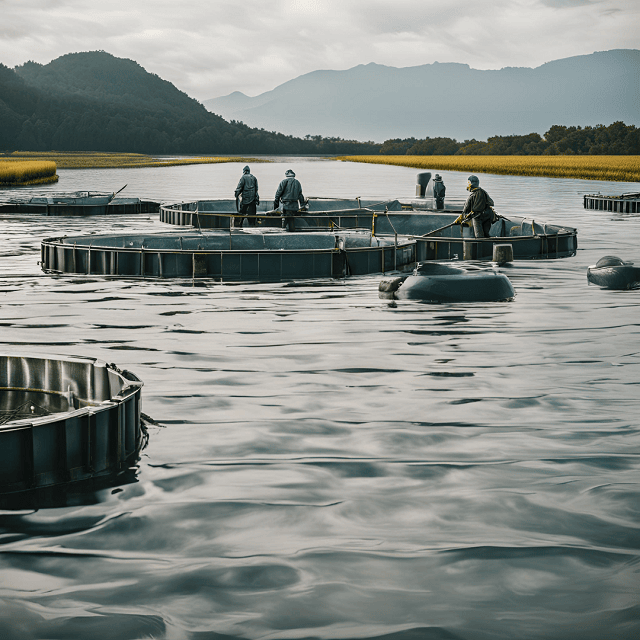
Oyster farming, a vital economic activity in coastal regions, is often threatened by natural disasters, particularly typhoons. Traditional bamboo rafts, commonly used for oyster farming, are vulnerable to damage during these extreme weather events.
To enhance the resilience of oyster farming, a novel approach involves constructing highly flexible polyethylene rafts. The superior flexibility and durability of this material offer a promising solution to mitigate the impacts of typhoons.
In this regard, a team of researchers from Osaka Prefecture University (Japan), The University of Osaka (Japan), and Osaka Metropolitan University (Japan) proposed an oyster farming raft made of highly flexible polyethylene (PE) and implemented a time-domain analysis model to evaluate the motion characteristics and deformation performance of polyethylene rafts.
Challenges of Traditional Oyster Farming Rafts
- 1 Challenges of Traditional Oyster Farming Rafts
- 2 Polyethylene Rafts: A Promising Alternative
- 3 Polyethylene Rafts: A Numerical Approach
- 4 Model Validation: Experimental Testing
- 5 Comparison of Numerical and Experimental Results
- 6 Sensitivity Analysis: Raft Design Optimization
- 7 Conclusion
- 8 Entradas relacionadas:
Traditional oyster farming rafts, primarily constructed of wood or bamboo, face several challenges:
- Susceptibility to Damage: These materials are vulnerable to storms, waves, and marine organisms, leading to frequent repairs and maintenance.
- Environmental Impact: Damaged rafts can contribute to ocean pollution and disrupt marine ecosystems.
- Reduced Oyster Growth: Vibrations caused by wind and waves can negatively affect the feeding and growth of oysters.
Polyethylene Rafts: A Promising Alternative
Polyethylene rafts offer a promising solution to the limitations of traditional rafts. Made from a durable and flexible material, PE rafts are:
- Resistant to Damage: PE is less prone to breakage and weathering, reducing maintenance costs and ensuring a longer lifespan.
- Environmentally Friendly: PE is recyclable and less likely to contribute to ocean pollution.
- Enhanced Oyster Growth: PE rafts are less susceptible to vibrations, creating a more stable environment for oyster development.
Polyethylene Rafts: A Numerical Approach
To assess the performance of PE rafts in wave-dominated environments, this research combines numerical analysis with model testing. A time-domain analysis model is used to simulate the motion and deformation of rafts under various wave conditions. The model is validated through experimental testing, comparing the predicted bending deformations and raft movements with real-world observations.
The model can simulate the movement characteristics and deformation behavior of rafts under various wave conditions. By understanding the elasticity of polyethylene, the model can provide valuable insights into the structural integrity and resilience of the rafts.
Model Validation: Experimental Testing
To validate the accuracy of the numerical model, tests were conducted with a 1:6.75 scale model in a water tank. Aluminum plates, with a bending stiffness similar to that of full-scale polyethylene rafts, were used to represent the rafts. Bending deformations were measured at three locations on the aluminum plates under normal wave conditions.
Stay Always Informed
Join our communities to instantly receive the most important news, reports, and analysis from the aquaculture industry.
Comparison of Numerical and Experimental Results
The results of the numerical model were compared with the experimental data. The comparison revealed a strong correlation between the predicted and observed displacements and bending deformations in the physical experiments. This validation confirms the reliability of the numerical model for evaluating the performance of polyethylene rafts.
Sensitivity Analysis: Raft Design Optimization
A sensitivity analysis was performed on the numerical model to explore the impact of different parameters, such as raft dimensions, material properties, and wave conditions, on raft performance. This analysis helps identify the most critical factors influencing the resilience of the rafts and provides valuable guidance for optimizing their design.
Conclusion
The development of polyethylene rafts presents a promising solution for improving the sustainability of oyster farming. By combining numerical modeling and experimental validation, this study has demonstrated the potential of these innovative rafts to withstand the challenges posed by typhoons. The insights gained from this research can be used to inform future raft designs and contribute to the long-term viability of oyster farming in coastal regions.
Associate Professor Yasunori Nihei of the OMU School of Engineering led the team in executing the numerical analysis and performance verification by constructing a test model of the polyethylene raft.
“It is expected that the numerical analysis technique developed in this research will be applicable not only to oysters but also to the performance evaluation of aquaculture ponds,” said Professor Nihei. “We hope that our efforts will greatly contribute to the future growth of the aquaculture industry.”
Finally, if you are interested in oyster farming, you can download this FAO manual and review this research to learn about the profitability of this aquaculture practice.
Contact
Yasunori Nihei
Graduate School of Engineering, Osaka Metropolitan University
Email: nihei@omu.ac.jp
Reference (open access)
Tamura, H., Iwamatsu, S., Iijima, K., & Nihei, Y. (2024). Motion characteristics and deformation performance of highly flexible polyethylene rafts for oyster farming. Ocean Engineering, 310, 118537. https://doi.org/10.1016/j.oceaneng.2024.118537
Editor at the digital magazine AquaHoy. He holds a degree in Aquaculture Biology from the National University of Santa (UNS) and a Master’s degree in Science and Innovation Management from the Polytechnic University of Valencia, with postgraduate diplomas in Business Innovation and Innovation Management. He possesses extensive experience in the aquaculture and fisheries sector, having led the Fisheries Innovation Unit of the National Program for Innovation in Fisheries and Aquaculture (PNIPA). He has served as a senior consultant in technology watch, an innovation project formulator and advisor, and a lecturer at UNS. He is a member of the Peruvian College of Biologists and was recognized by the World Aquaculture Society (WAS) in 2016 for his contribution to aquaculture.




